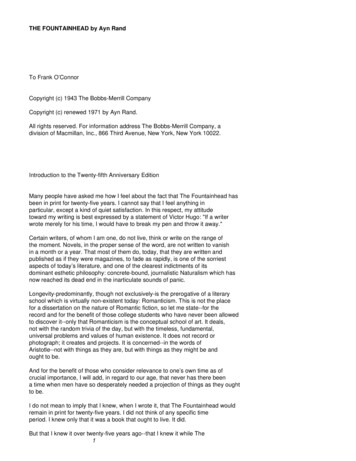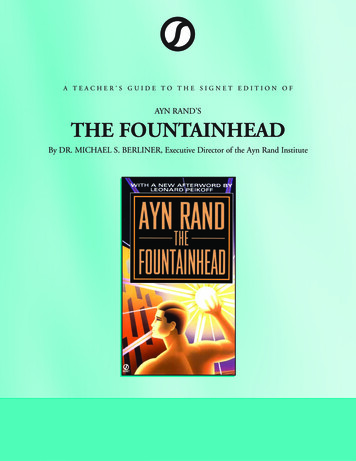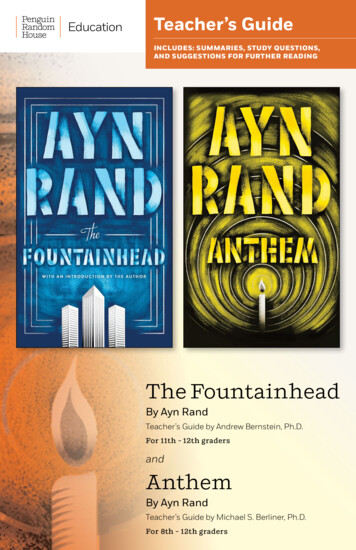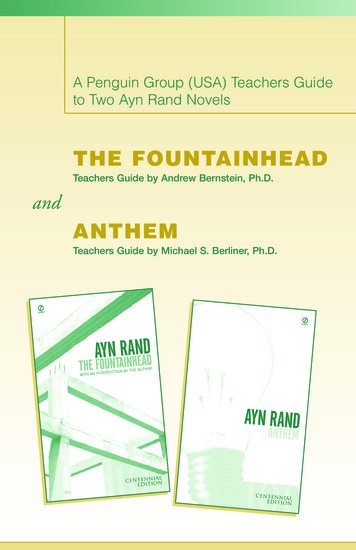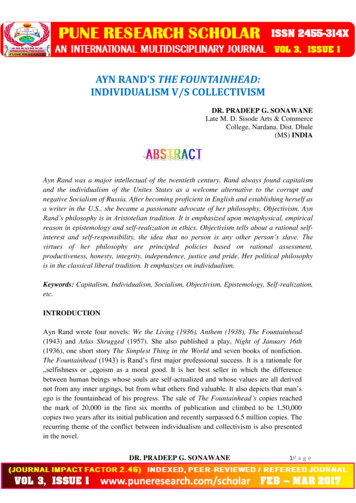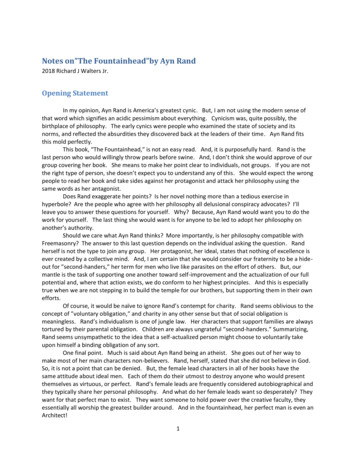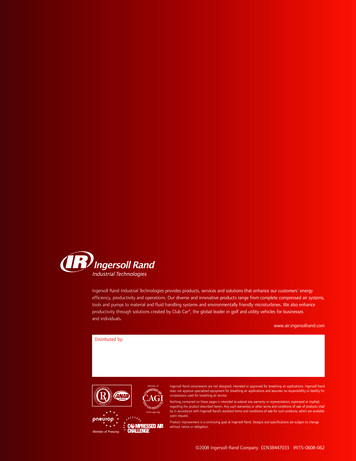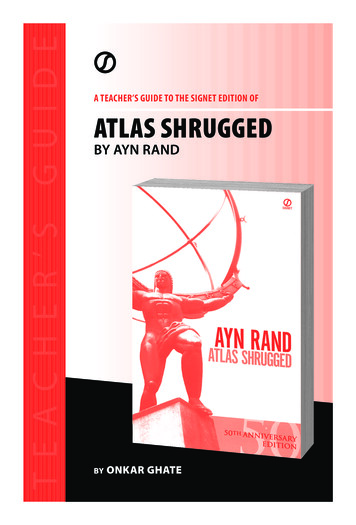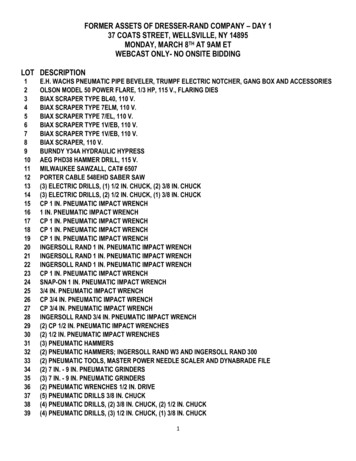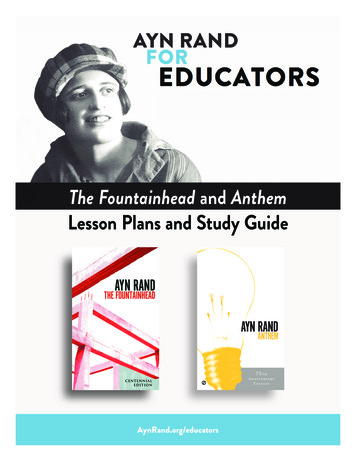
Transcription
AYN RANDThe Fountainhead and AnthemLesson Plans and Study GuideAynRand.org/educators
The Fountainhead—Lesson Plan and Study Guide Ayn Rand Institute 2016Anthem—Lesson Plan and Study Guide Ayn Rand Institute 2016
The Fountainhead Lesson Plan and Study GuideBy Andrew BernsteinDr. Bernstein received his PhD in philosophy from the Graduate School of the City University of New York. Heteaches at the State University of New York at Purchase, where he was selected Outstanding Faculty Member for2004. He is the author of The Capitalist Manifesto: The Historic, Economic and Philosophic Case for Laissez-Faire, published byUniversity Press of America in 2005. His most recent book is Objectivism in One Lesson: An Introduction to the Philosophy ofAyn Rand, published by Hamilton Books in 2008.UNDERSTANDING THE PLOT: QUESTIONS FOR STUDYPart One1. Explain in detail the reasons for Howard Roark’s expulsion from the Stanton Institute of Technology.The Dean states that Roark has “a determined little group of defenders” among the faculty, whileother professors “felt it their duty” to vote for his expulsion. Why do the faculty members on each sideevaluate Roark and his work so differently?2. At the end of chapter 1, Roark comprehends that there is a fundamental difference between hisapproach to life and the Dean’s. Roark understands his own, but not that of the Dean and those likehim. He recognizes that there is a principle that explains the difference, which he calls the “principlebehind the Dean.” Based on subsequent events of the story, explain the “principle behind the Dean.”3. Peter Keating graduates as valedictorian from the Stanton Institute of Technology. Does this mean thathe is an outstanding architecture student? By what methods did he get such high grades? What does thissay regarding his moral character?4. Keating goes to work for Guy Francon, the most successful and prestigious architect in the country.What are the methods by which Francon has achieved commercial success? Does he have anything incommon with Keating? In what ways do they both differ from Roark?5. Roark gains employment with Henry Cameron. Cameron, though a genius, is a commercial failure.Why has society rejected his work? Why does Roark nevertheless revere him? What qualities do Roarkand Cameron share in common? What is the fundamental difference between them and Francon andKeating?6. Citing specifics from the story, describe the means by which Keating seeks to rise to the top of Francon’sfirm? Explain the meaning of Keating’s methods. Why do they work at Francon’s? Would Keating’smethods work similarly well at Cameron’s? Why?7. Though Keating often leaves Catherine Halsey waiting weeks for him to call, the author makes it clearthat Catherine is special to him. How does the author show Keating’s love for Catherine? In contrastto Keating’s motive for pursuing his other values (in work, e.g.), what personal significance does hisrelationship with Catherine have? What fate will befall Peter if he betrays his love for her?8. The design of the Cosmo-Slotnick Building establishes Keating’s fame. What is the nature of Keating’srelationship with Roark at this point in the story? Why does Keating both approach him for advice andhelp and take pleasure in making him perform menial tasks while an employee at Francon’s? Why doesKeating feel a need to degrade the man who is his meal ticket?The Fountainhead Lesson Plan and Study Guide 2016 Ayn Rand Institute1
9. Cameron and Roark, though brilliant designers, get few commissions. At one point Cameron urgesRoark to surrender his principles and design conventionally. Given that Cameron himself neither didnor would do such a thing, what is the meaning of that scene? What does Ayn Rand stress about theprice paid by great creative thinkers in a society that does not recognize the merit of their new ideas?10. Austen Heller hires Roark to build a private home, giving him his first commission. What qualities doesHeller possess that enable him to recognize the merit of Roark’s work when virtually the entire societydoes not? Despite the professional differences between Heller’s and Roark’s other supporters, e.g., Mike,Mallory, Enright, what fundamental attribute do they share in common? What point does the authormake regarding the ability to recognize genius?11. The character of Dominique Francon is introduced in this section. Dominique criticizes the work ofher own father in her newspaper column and recognizes the fraudulent nature of Keating’s work andcharacter, though many admire him. What does Ayn Rand thereby show the reader about Dominique?Why is this important for the reader’s ability to understand her coming relationship with Roark?12. Despite extreme poverty Roark refuses the lucrative commission for the Manhattan Bank Buildingrather than permit the adulteration of his design. When the Board asserts that he is “fanatical andselfless,” Roark responds that his action was “the most selfish thing you’ve ever seen a man do.” Giventhat Roark has just turned down a major commission in order to protect the integrity of his design,what is “selfish” about this? What is Ayn Rand’s view of “selfishness” and “selflessness”? Contrast herview to that of Christianity and of socialism.13. Compare Howard Roark and Lois Cook. Are they both individualists? Why or why not?Part Two1. At the granite quarry Dominique is deeply attracted to the red-headed worker who stares at herinsolently. She pursues him aggressively, but resists him in the moment of her triumph. Given thatDominique is eager to make love to Roark, why does she physically resist? Ayn Rand once statedregarding this scene that if it is rape, “then it is rape by engraved invitation.” What does she mean? Isthis actually rape, i.e., is Dominique an unwilling victim?2. Though strongly attracted to Roark, Dominique both pursues and fights him. Is this inner conflictregarding her love representative of some deeper aspect of her character? How does this ambivalencerelate to her destruction of the Greek statuette that she loves? to joining forces with Ellsworth Toohey inan effort to wreck Roark’s career? to refusing to pursue a serious career in spite of her great intelligence?Are Dominique’s motives for thwarting Roark the same as Toohey’s?3. At this point in Roark’s career he is hired by Roger Enright, Anthony Cord and Kent Lansing toconstruct major buildings. What kind of men are Enright, Cord and Lansing? Do they share somefundamental characteristic in common with each other and with Austen Heller? What does Lansingmean when he tells Roark that “the shortest distance between two points is not a straight line—it’s amiddleman”?4. At Kiki Holcombe’s party Keating gives advice to Roark. He says: “Always be what people want youto be.” What is the meaning of such a statement? Why does Keating believe this? What does such anapproach to life reveal about the soul of Keating and of people like him?5. At the same party Dominique thinks of Roark as having “the face of a god.” What is she responding toin Roark? In seeing such beauty in Roark’s face, an evaluation not shared by the rest of society, whatdoes Dominique reveal about her own soul?2The Fountainhead—Lesson Plan and Study Guide Ayn Rand Institute 2016
6. Dominique begins to write about Roark’s buildings in her column. She words them in such a way asto give the appearance of criticism while actually offering extravagant praise. Why does she hope thatRoark’s buildings will be destroyed in a future air raid? What is her view of human society, and of thepossibility of great men succeeding in it?7. Toohey convinces Hopton Stoddard to hire Roark to build the Stoddard Temple. What is Toohey’spurpose? Why does he seek to brand Roark an enemy of religion? What is Toohey’s deeper reason forattempting to end Roark’s career?8. Though Dominique testifies for the plaintiff at the Stoddard Temple trial, she praises the building andcriticizes both Toohey and society. Why does she want the building torn down? How do her motivesdiffer from Toohey’s? In what way is the trial Dominique’s worst nightmare come true?9. Roark hires Mallory to do the sculpture for the Temple, but Mallory, despite his youth, is already bitter anddisillusioned. What is the cause of Mallory’s nascent cynicism? What does Roark do that helps Malloryovercome his disillusionment? Are there similarities between Mallory’s early career and the life of HenryCameron?10. After the trial Dominique accepts Keating’s earlier proposal and marries him. Given her undying lovefor the integrity of Roark’s buildings and person, and her recognition that Keating is the antithesisof everything she reveres, it is appropriate to ask what Dominique seeks in such a marriage. For whatpurpose does she marry the man she considers society’s most despicable representative?11. At the end of part 2, Roark’s career is again at low ebb and it appears that Toohey’s scheming has beensuccessful. Toohey seeks him out to ask what Roark thinks of him. What does this question revealabout Toohey’s soul? Roark answers in simple honesty that he does not think of him. What does suchan answer reveal about Roark’s soul? These two characters represent the fundamental antipodes in theuniverse of the novel. What is the primary difference between them?Part Three1. Gail Wynand is a brilliant individual who rose out of the slums by means of his own talent and effort.But despite his reverence for man’s noblest achievements, his newspaper presents lurid, loathsomevalues. Why does Wynand pander in this manner? What is the meaning of such a self-betrayal?2. Toohey presents Mallory’s sculpture of Dominique to Wynand in an effort to bring Dominique andWynand together. What is the purpose of Toohey’s scheme? Why does he need something to distractWynand’s attention away from his newspaper?3. What is Toohey’s overall purpose on the New York Banner? What is his overall purpose in regard tosociety in general? Dominique warns Wynand against Toohey, but he is too contemptuous of Toohey toheed her. Is Dominique correct in her assessment of Toohey’s actual motives?4. What is Dominique’s motive in marrying Wynand, for becoming “Mrs. Wynand Papers”? Does it bear anysimilarity to her reason for marrying Keating? Does she accomplish the goal she set out to reach? Tie thisdiscussion to the quote from Nietzsche—that nobility of soul is not to be lost—that the author cites inthe introduction to the 25th anniversary edition: “It is not the works, but the belief which is here decisiveand determines the order of rank—to employ once more an old religious formula with a new and deepermeaning,—it is some fundamental certainty which a noble soul has about itself, something which is not tobe sought, is not to be found, and perhaps, also, is not to be lost.—The noble soul has reverence for itself.—”(Friedrich Nietzsche, Beyond Good and Evil)The Fountainhead—Lesson Plan and Study Guide Ayn Rand Institute 20163
5. Why does Wynand fall deeply in love with Dominique? Do they share noble qualities in common? Havethey made a similar mistake? Because of Wynand’s undeniable virtues, do Dominique’s feelings for himchange?6. On her way to Reno to secure a divorce from Keating, Dominique stops in Clayton, Ohio, to visit Roark.Why is Dominique willing to marry Roark only if he renounces architecture? What is the meaning ofRoark’s response that if he wanted to be cruel, he would accept her proposal? Aside from the obviousfact that she loves Roark, what does this visit show the reader about Dominique?Part Four1. Roark’s resort at Monadnock Valley provides for a disillusioned young man, who had always wanted towrite music, “the courage to face a lifetime.” Given that Roark had never met the boy before, and wouldnever see him again, what point does the author make regarding the nature of creative achievement?Contrast this episode with the effect that Toohey’s counseling has on the young people who come tohim for advice. Which has a benevolent impact on other men—Roark’s life of personal accomplishmentor Toohey’s call for sacrifice to the collective?2. Although Roark receives the commission for Monadnock Valley as part of a swindle by the owners, hiswork is so highly valued by the customers that the resort makes money despite its fraudulent origins.Further, Roark has been kept busy over the previous several years designing a variety of small structures.“It was as if an underground stream flowed through the country and broke out in sudden springs thatshot to the surface at random, in unpredictable places.” What is the nature of this “stream” that nowflows in recognition of Roark? There is an old saying that “the truth will win out.” What does Ayn Randshow regarding society’s ultimate response to the great work of a creative genius?3. Gail Wynand hires Roark to build a fortress to protect Dominique from human society. Despite theirony, there is almost an inevitability to this event. Why does Wynand choose Roark from among all thearchitects of the country? Why is it fitting? What is the essence of their bond?4. As Roark enters the building that houses Wynand’s paper, he remembers Henry Cameron’s words thatWynand and the mindless conventionality that his papers represent are the fundamental cause of theworld’s ills. Despite this, Roark comes to love and respect Wynand beyond all others, even stating at onepoint, “You have been the one encounter of my life that can never be repeated.” Why does Roark loveWynand despite the deathbed warning against him from Cameron? Despite his flaws, what major virtuesdoes Wynand possess?5. By this time Peter Keating’s career is badly slipping, as Toohey pushes his new protege, Gus Webb. Whydid Toohey support Keating in the first place? What is Toohey’s purpose in promoting the careers ofsuch mediocrities as Keating, Gordon Prescott, Lois Cook, Ike the Genius, and Webb? In what way doeshis purpose integrate with his anti-Roark campaign?6. Why is Roark’s brilliant design for Cortlandt Homes altered by Gus Webb and Gordon Prescott? Whatfactors in society make it possible? Why is Keating, despite his best efforts, powerless to stop it?7. In dynamiting Cortlandt Homes, Roark breaks the law. What is his moral and philosophical argumentfor the rectitude of his action?8. Dominique assists Roark in the dynamiting, and tells him that she will wait for him even if he servestime in prison. She is no longer afraid of what society will do to him. What is the essence of Dominique’schange in thinking? What error had she previously made that she now corrects? What enables her tofinally see the truth? How does her change of mind integrate with the novel’s theme?4The Fountainhead—Lesson Plan and Study Guide Ayn Rand Institute 2016
9. When Wynand defends Roark in the New York Banner, it is the first time that, in the deepest sense, thepaper belongs to him and not to the crowd. This is exactly why his crusade fails. Why does Wynand fillthe paper with his own values only now? Why is it too late? Explain Wynand’s failure to save Roark—andhimself—in terms of the mixed premises that form the essence of his character.10. Wynand closes the New York Banner rather than turn control of it over to Ellsworth Toohey. Whatkindof defeat does this represent for Toohey? In terms of Toohey’s two principal goals—to preventRoark’s success, and to control the New York Banner—he fails utterly. What point does the author makeregarding the nature and power of evil men?11. In his courtroom speech Roark discusses the outstanding innovators who have carried mankindforward, arguing that it was their independent thinking—not compliance with their brothers—thatenabled them to reach their monumental achievements. In terms of some of history’s great independentminds—Galileo, Darwin, Pasteur, the Wright Brothers, et al.—explain and defend Roark’s thesis.12. At the end of the novel, Roger Enright buys Cortlandt Homes and hires Roark to build it in accordancewith his original design. Wynand hires Roark to erect the Wynand Building, the world’s tallestskyscraper. Roark marries Dominique Francon. He has succeeded completely, and on his own terms.What point does the author make regarding the nature of success? In contrast to the evil Toohey, whatpoint does she make regarding the nature and power of the good?The Fountainhead—Lesson Plan and Study Guide Ayn Rand Institute 20165
RESEARCH ON THE NOVEL’S PHILOSOPHICAL CONTENT(Challenging work for the most advanced students) Read book 4, chapter 3, of Aristotle’s Nicomachean Ethics (and as much of the rest of Aristotle’s ethicsas possible) and write an essay answering the question: Does Howard Roark qualify as an example ofAristotle’s “proud man” (sometimes translated as “the great-souled man”)? Read Ayn Rand’s novel Atlas Shrugged. Both novels are about the role of the mind in man’s life.In The Fountainhead the focus is on the individualistic nature of the mind’s functioning, while inAtlas Shrugged the emphasis is on the mind as man’s tool of survival. Compare Ayn Rand’sunderstanding of the mind’s role in human life as presented in The Fountainhead with the broader anddeeper understanding in Atlas Shrugged. Read Marx and Engels’s The Communist Manifesto. Is the collectivist society envisioned by EllsworthToohey consistent with the communist state advocated by Marx and Engels? Read Ayn Rand’s The Virtue of Selfishness or Leonard Peikoff’s Objectivism: The Philosophy of Ayn Rand. Howdoes Howard Roark’s character and life illustrate Ayn Rand’s theory of rational egoism?CLASS PROJECTS(There are many things that students can do, in addition to writing critical essays,that will enhance their understanding of The Fountainhead.)1. Discuss in class what the world would be like if Roark’s ideas were the dominant philosophy. If Toohey’sideas were preeminent. If Keating’s were. If Dominique’s were.2. Dramatize a scene from the novel, with students playing the parts of the relevant characters. Present thescene in accordance with your best understanding of the novel’s meaning.3. Create a Web site that explains to other people what you find illuminating and exciting about the book.Explain what advantages they will derive from reading it and understanding the novel’s theme.4. Debate in class the contrasting philosophical theories that the story dramatizes, with some studentsdefending the individualism of Roark, and others the collectivism of Toohey.5. Write a letter to Ayn Rand describing your reaction to The Fountainhead. Did you find it uplifting,exciting, educational? Many people have found that reading this book gave them the courage to pursuetheir own dreams. Describe to the author your own response to it.6. Write a letter to the editor of your local newspaper, arguing that the individualistic philosophy ofHoward Roark is the solution to specific contemporary problems, e.g., racism, drugs, poverty, crime, war.6The Fountainhead—Lesson Plan and Study Guide Ayn Rand Institute 2016
UNDERSTANDING THE NOVEL’S THEME1. Since the novel is deeply philosophical, it is important for the student to learn definitions for the book’srelevant philosophical terms.(a) i ndependence: reliance on one’s own thinking in the search for truth, and on one’s own effortto support oneself. To Ayn Rand, independence is fundamentally a cognitive concept. It meansthe willingness to think, to go by one’s own best judgment, to never accept a claim as true merelybecause others believe it. Independence does not preclude cooperation or friendly relations inhuman society, e.g., Roark’s cooperative work, in different forms, with Cameron, Mallory, Mike—and his close relationships with, notably, Dominique, Cameron and Wynand. It is important forthe student to recognize that independence is not the rugged individualism of the type that entailssurvival by oneself in the wilderness or the mountains. The best examples of independence arethe great men of the mind who have discovered new truths, often in the teeth of intense socialopposition, and have consequently carried mankind forward, e.g., inventors like Robert Fulton,innovative architects like Frank Lloyd Wright, scientists like Marie Curie, entrepreneurs like HenryFord.(b) d ependence: permitting other people to dominate one’s thinking and one’s life; a refusal to think, awillingness to derive one’s beliefs uncritically from others, either by means of blind obedience or anequally blind rebellion. Both conformists and nonconformists, each in their own way, are examplesof dependency.(c) c onformity: living in unthinking adherence to the judgment, the standards, the values of others. Inthe novel Peter Keating is, of course, the outstanding example of this.(d) i ndividualism: the philosophy of man that emphasizes the reality and cognitive efficacy of theindividual. Individuals are real, not splintered fragments of the group; they can and should beautonomous thinkers, not molded playthings of “social conditioning.” Politically, individuals mustbe free to act on their own thinking and live their own lives. The political/economic system thatis the logical culmination of individualism is limited constitutional government and laissez-fairecapitalism, because it is this system alone that protects the rights of the individual. Howard Roarkis, of course, an outstanding fictional representative of individualism.(e) c ollectivism: in contrast to individualism, the philosophy of man that emphasizes the reality andcognitive efficacy of society as a whole. Only the group is real, only the group’s beliefs determinetruth. The individual is merely a fragmented chunk of the whole, whose thinking is conditionedand controlled by the beliefs of society. Individuals have no rights. Politically, the state is allpowerful and the individual must unquestioningly obey the will of society. The political/economicsystem that is the logical culmination of collectivism is socialism in some form, whether NationalSocialism (Nazism), communism or fascism. In the book Ellsworth Toohey is the leading advocateof collectivism.(f) f irst-handers: those independent thinkers who face nature directly and thereby survive first-hand,i.e., by their own effort. These are the individuals who discover how to make fire, how to grow cropsand domesticate livestock, how to cure diseases, how to build homes, etc.—and also those who usetheir own minds to learn from the innovators, and are therefore able to live productively.(g) s econd-handers: those dependent persons who, in one form or another, are not productive, do notsurvive by means of their own mind or effort, but who, rather, survive second-hand by leechingoff of others. There are many types of second-handers—criminals, family bums, welfare recipients,military conquerors, political dictators, social climbers (like Keating) and others.2. Ayn Rand states that the theme of The Fountainhead is: “individualism vs. collectivism, not in politics butin men’s souls.” Explain fully what she means.The Fountainhead—Lesson Plan and Study Guide Ayn Rand Institute 20167
3. The central conflict of the novel is the contrast of and conflict between first-handers and secondhanders. Using both examples from the novel and from real life, examine the nature of this conflict.4. Related to the theme is the relationship of the moral and the practical. Wynand and Dominique bothbelieve that men of integrity have no chance to succeed in society, that only the corrupt make it to thetop. Based on their view that men must choose between corrupt success and noble failure, they makedifferent choices. Wynand opts for success by any means while Dominique chooses to pursue no valuesin a world in which success would require her to sell her soul. Roark, on the other hand, rejects the beliefthat men must make such a choice. He believes that morality and success stand in direct, not in inverse,proportion to each other, that success is achieved not by compromising one’s soul but by remaining trueto it. Based on events in the story, analyze Ayn Rand’s thinking regarding the relationship between themoral and the practical.8The Fountainhead—Lesson Plan and Study Guide Ayn Rand Institute 2016
COMPARE AND CONTRAST WITH OTHER LITERARY WORKS1. In dynamiting Cortlandt and waiting to be arrested, Roark breaks the law deliberately in order to makethis a test case. In Washington and Lee’s play, Inherit the Wind, high school biology teacher Bertram Catesalso breaks the law with the conscious intent of going to court and putting the law on trial. In bothcases the hero (and/or his lawyer) fights a legal/intellectual battle in support of a moral principle. Whatare the similarities and differences between the struggles waged by these intellectual heroes?2. In Chaim Potok’s novel The Promise, the main character, Danny Saunders, struggles with the conflictbetween independent living and conformity to tradition. In what ways are the battles waged by Dannyand Howard Roark similar? Are there important differences in the nature and outcome of theirrespective struggles? Do Chaim Potok and Ayn Rand value independence equally?3. In Sinclair Lewis’s Babbitt, the main character, George Babbitt, is an abject conformist of the Peter Keatingilk. Compare and contrast the two characters. By using Keating as a foil to the independent Roark, doesAyn Rand achieve a deeper level of understanding than does Lewis regarding the nature of conformity?4. Gail Wynand is a great man who destroys himself by means of his moral flaws. Does he qualify as atragic hero by the definition expounded in Aristotle’s Poetics? Compare his life and the causes of hisdownfallwith one of the great tragic figures of literature, e.g., Oedipus, Antigone, Macbeth, Hamlet, Othello.5. In refusing to send Dominique back to Wynand, Roark will not sacrifice himself and his love forWynand. How does this compare—in Rostand’s Cyrano de Bergerac—to Cyrano’s choice not to tell Roxaneof his love in order to honor the memory of his dead friend Christian?6. In Hamlet Polonius urges his son, Laertes, “to thine own self be true.” In The Fountainhead Roark livesout this principle, refusing to ever be untrue to his self. In one scene in which he refuses to compromisehis design in exchange for a lucrative commission, he states, “That was the most selfish thing you’veever seen a man do.” Is Roark true to his self in the sense that Shakespeare means? What is Ayn Rand’smeaning of being true to the self? Based on the events of Hamlet (or other of Shakespeare’s plays) wouldthe great English poet agree with Ayn Rand?The Fountainhead—Lesson Plan and Study Guide Ayn Rand Institute 20169
THE PERSONAL SIGNIFICANCE OF THE NOVEL1. High school and college students often struggle with questions of personal identity, career choice, andparental and peer pressure. Students can discuss and/or write on the question of what The Fountainhead’smessage of independence means to them personally.2. Just as Roark’s accomplishment at Monadnock Valley gave to the boy who had always wanted to writemusic the courage to face a lifetime, so Ayn Rand’s achievement in The Fountainhead has changed manypersons’ lives. Discuss the inspiration that can be derived from the sight of a heroic achievement.THE INFLUENCE OF THE FOUNTAINHEAD ON FILMS1. The theme of the movie Dead Poets Society is independence vs. conformity—the same theme asThe Fountainhead. Compare and contrast Dead Poets Society to The Fountainhead. Discuss the similaritiesand differences of these views of independence, conformity and man’s fundamental outlook on life.2. The Australian film Strictly Ballroom features a young hero attempting to introduce new steps intoballroom dance competition. He is opposed by the heads of the dance federation who hold that all theproper steps of ballroom dancing have been identified long ago by the great dancers of the past. Whichfundamental principles are shared by this film and The Fountainhead? Are there any important differencesin their understanding of human nature and human life? If so, what are they?3. Compare and contrast the philosophic ideas presented in Dead Poets Society and Strictly Ballroom. Whichof these two films is closer to the outlook on human life as presented in The Fountainhead? Explain youranswer fully.10The Fountainhead—Lesson Plan and Study Guide Ayn Rand Institute 2016
Anthem Lesson Plan and Study GuideBy Lindsay JosephMs. Joseph received her Honors Bachelor of Arts and Bachelor of Education from York University, her HonorsSpecialist Certification in the Teaching of English from the University of Toronto, and her AMI PrimaryDiploma from the Montessori Institute of San Diego. She has worked as a teacher and administrator at variousprivate schools in Toronto, Canada, and in California, where she specialized in teacher training and curriculumdevelopment. Ms. Joseph is currently working as an executive program developer at Higher Ground Education inLake Forest, California.DETAILED CHAPTER QUESTIONSNOTE: All page numbers cited refer to the Anthem Student Edition.Chapter I1. (a) In a well-organized paragraph, describe the society in which Anthem is set. Some areas to consider arethe political structure, degree of technology, social relationships, quality of life, and education.(b) Would you want to live in this society? Explain why or why not.2. In this chapter Equality 7-2521 states that it is very unusual for men to reach the age of 45. Offer severalpossible explanations as to why life expectancy is so short in his society.Term andExamples from Anthem(a) Why is this character or actDefinition(Try to find several examplescondemned in Anthem?per term)(b) Should it be condemned?Explain why or why not. Transgression: theTransgression of Preference:breaking of a lawEquality chooses Internationalor oath4-8818 as his friend (p. 30). Sin: Curse: Crime: Evil: Dam
The Fountainhead Lesson Plan and Study Guide By Andrew Bernstein Dr. Bernstein received his PhD in philosophy from the Graduate School of the City University of New York. He teaches at the State University of New York at Purchase, w
